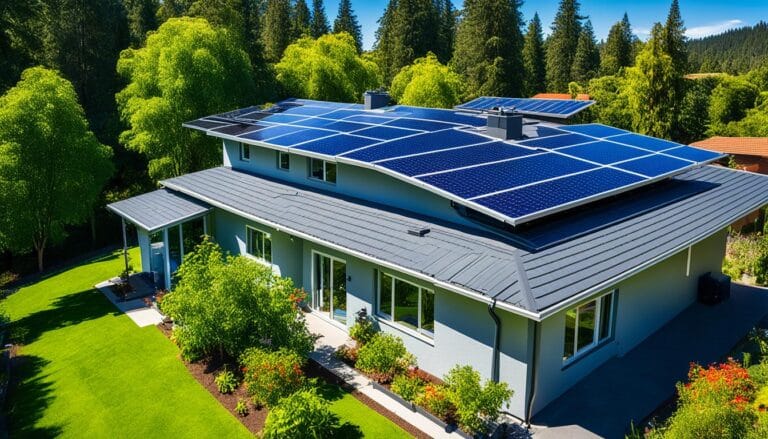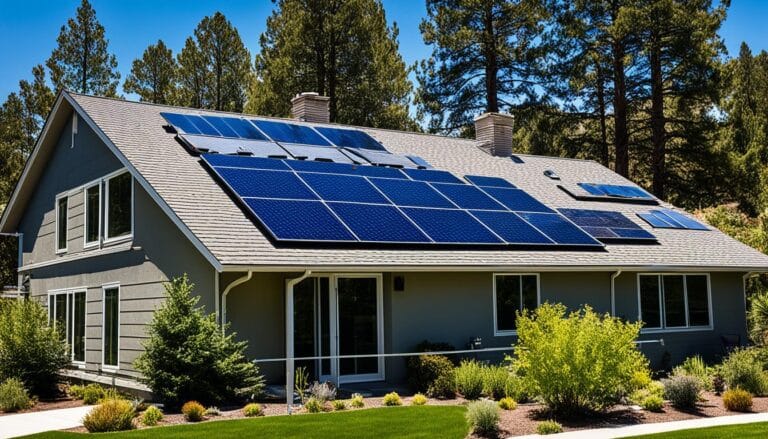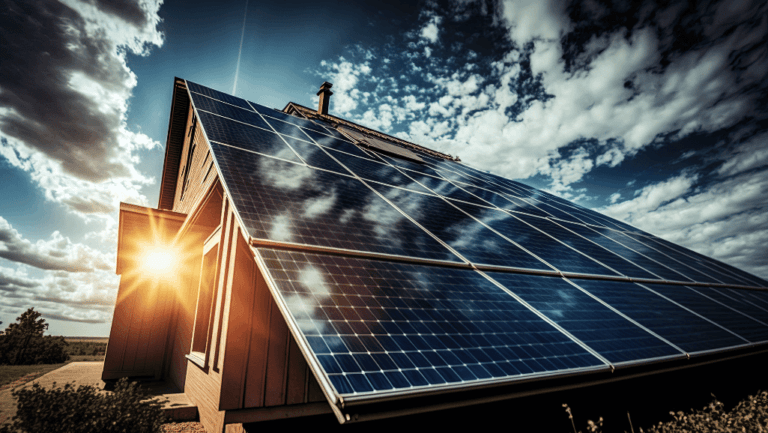Solar grants are powering the future of clean energy in America. These renewable energy incentives are helping homeowners, businesses, and communities embrace solar technology. The U.S. Department of Energy (DOE) is leading the charge with substantial funding for solar energy research and development.
In 2024, the DOE’s Solar Energy Technologies Office (SETO) announced a whopping $217 million for its Lab Call FY2025-27 program. This funding supports various solar initiatives, from cutting-edge photovoltaics to innovative manufacturing techniques. Solar panel rebates and grants are making clean energy more accessible than ever before.
The impact of these solar grants extends beyond research labs. For example, the Rural Energy for America Program offers grants covering up to 75% of eligible project costs. This program is helping rural communities switch to solar power, boosting energy independence and reducing costs.
States are also getting in on the action. New Hampshire received over $43 million to bring community solar benefits to low-income areas. Massachusetts allocated $156 million for solar projects in disadvantaged communities. These initiatives are making solar energy a reality for more Americans every day.
Key Takeaways
- The DOE allocated $217 million for solar research in 2024
- Rural Energy for America Program covers up to 75% of project costs
- State-level grants are bringing solar to low-income communities
- Solar grants support research, manufacturing, and adoption
- Funding opportunities exist for homeowners, businesses, and communities
Understanding Solar Grants and Their Importance
Solar grants play a vital role in promoting clean energy adoption. These financial incentives, offered by various entities, help make solar power more accessible to individuals and organizations. Let’s explore the world of solar grants and their impact on green energy initiatives.
What Are Solar Grants?
Solar grants are financial awards given to support the installation of solar energy systems. Unlike loans, these grants don’t need to be repaid. They target diverse groups, including low-income homeowners, rural communities, farms, schools, and non-profit organizations. The goal is to boost green energy subsidies and increase solar adoption across different sectors.
Benefits of Solar Grants
Solar grants offer numerous advantages for clean energy adoption:
- Reduced installation costs
- Increased energy independence
- Lower electricity bills
- Environmental protection
- Job creation in the renewable energy sector
Types of Solar Grant Programs
Various solar grant programs exist to support different needs:
| Program Type | Description | Eligibility |
|---|---|---|
| Federal Grants | Includes ITC and REAP | Homeowners, businesses, farmers |
| State-Level Grants | Varies by state | Residents, local businesses |
| Tribal Energy Program | Funds new solar projects | Tribal communities |
| Green Retrofit Grants | For energy-efficient upgrades | Existing buildings |
These programs work alongside other incentives like solar tax credits and solar installation financing options. By combining grants with tax benefits and financing, individuals and organizations can significantly reduce the cost of going solar.
Federal Solar Grant Programs
The U.S. government offers various solar energy grants and photovoltaic system funding opportunities. These sustainable energy programs aim to boost clean energy adoption across the nation.
Inflation Reduction Act (IRA) Initiatives
The IRA provides significant funding for solar initiatives. It includes tax credits and rebates for residential solar installations, making clean energy more accessible to homeowners.
Rural Energy for America Program (REAP)
REAP offers grants and loan guarantees for renewable energy projects, including solar. Rural small businesses and agricultural producers can benefit from this program to implement sustainable energy solutions.
Department of Energy (DOE) Funding Opportunities
The DOE’s Solar Energy Technologies Office (SETO) provides research grants for photovoltaics and solar-thermal power. Recent programs include:
- Advancing U.S. Thin-Film Solar Photovoltaics Funding Program ($44M)
- Solar Manufacturing Incubator Funding Program ($24M)
| Program | Budget | Focus Area |
|---|---|---|
| Solar Energy Equity Program | $6 million | Low-income households |
| Business Energy Investment Tax Credit | 30% tax credit | Commercial solar installations |
| Residential Renewable Energy Tax Credit | 30% tax credit | Residential solar systems |
These federal programs demonstrate the government’s commitment to advancing solar technology and expanding access to clean energy solutions across diverse communities.
State-Level Solar Grant Initiatives
State solar programs play a crucial role in promoting renewable energy adoption across the United States. Many states offer their own solar power initiatives to complement federal efforts. These state-level programs provide diverse renewable energy incentives, making solar energy more accessible and affordable for residents and businesses alike.
California stands out as a leader in solar energy production, generating about 29% of the total solar supply in the U.S. The Golden State offers several solar power initiatives to encourage widespread adoption. For instance, the Self-Generation Incentive Program (SGIP) provides rebates for energy storage systems, with higher incentives for low-income households and vulnerable communities.
Other states are following suit with their own renewable energy incentives. The Biden-Harris Administration’s $7 billion Solar for All are set to bolster these efforts, supporting state-level programs across the nation.
| State | Program | Incentive |
|---|---|---|
| California | SGIP | $0.85/Wh for eligible households |
| Massachusetts | SFA Program | $156,120,000 funding |
| New York | NYSERDA | $249,800,000 funding |
These state solar programs are designed to address specific local needs and barriers to solar adoption. For example, Massachusetts’ SFA Program focuses on historically underserved communities, while New Jersey’s initiative includes pillars for multi-family housing and community solar projects.
“State-level solar initiatives are key drivers in our transition to a clean energy future, making solar power accessible to all communities.”
Solar Grants for Residential Properties
Homeowners looking to harness clean energy can benefit from various residential solar grants and home solar incentives. These programs aim to make solar panel installation more affordable and accessible for American families.
Eligibility Criteria for Homeowners
To qualify for residential solar grants, homeowners typically need to meet specific requirements:
- Own the property where panels will be installed
- Meet income thresholds (varies by program)
- Have a suitable roof or property for solar installation
- Be connected to the electrical grid
Application Process
The application process for solar panel rebates usually involves these steps:
- Research available programs in your area
- Gather required documentation (proof of ownership, income verification)
- Submit application forms
- Schedule a home energy assessment
- Obtain and compare quotes from certified installers
Funding Amounts and Limitations
The amount of funding available through residential solar grants varies widely:
| Program Type | Typical Funding Range | Limitations |
|---|---|---|
| Federal Tax Credit | 30% of system cost | Reduces to 26% in 2033, 22% in 2034 |
| State Tax Credits | Up to 25% of system cost | Varies by state, may have caps |
| Local Rebates | $500 – $5,000 | Often first-come, first-served basis |
It’s crucial to note that solar energy plays a vital role in combating climate, making these incentives even more valuable. Homeowners should consult with solar professionals to maximize their benefits from available grants and rebates.
“Solar for All program seeks to mainstream solar energy, addressing challenges faced by low-income neighborhoods and aiming to benefit over 900,000 households.”
Solar Grants for Businesses and Agricultural Producers
Businesses and farms can tap into various commercial solar incentives to boost their clean energy adoption. The Rural Energy for America Program (REAP) stands out as a key source of business renewable energy funding. This program offers substantial financial support for solar installations and energy efficiency upgrades.
REAP provides impressive funding options. Eligible businesses can secure loan guarantees covering up to 75% of project costs. Grants are available for up to 50% of expenses. Combining grants and loans can fund up to 75% of a project. This level of support makes solar energy adoption more accessible for rural enterprises.
The program sets clear boundaries for funding. Renewable Energy System Grants range from $2,500 to $1 million. Energy Efficiency Grants span from $1,500 to $500,000. These figures highlight the program’s flexibility in supporting projects of various scales.
| Grant Type | Minimum | Maximum |
|---|---|---|
| Renewable Energy | $2,500 | $1,000,000 |
| Energy Efficiency | $1,500 | $500,000 |
REAP’s impact extends beyond direct funding. It aims to boost American energy independence and promote clean energy adoption. The program helps businesses reduce operational costs while contributing to sustainability goals. For agricultural producers, these agricultural solar grants can transform farm operations, making them more efficient and environmentally friendly.
“REAP grants have been a game-changer for our farm. We’ve cut energy costs by 40% since installing solar panels.”
Eligibility for REAP is straightforward. Businesses must be in rural areas with populations under 50,000. Agricultural producers need to derive at least 50% of their gross income from farming. This targeted approach ensures that rural communities and agricultural sectors benefit from clean energy transitions.
Community Solar Projects and Grant Opportunities
Community solar initiatives are revolutionizing energy access across the United States. These shared solar programs allow residents to benefit from clean energy without installing panels on their own properties.
Benefits of Community Solar Initiatives
Community solar grants make renewable energy accessible to a broader range of people. Solar energy cooperatives enable participants to save on electricity bills while supporting green energy production. In Maryland, the Community Solar LMI-PPA Grant Program has shown impressive results:
- 60 community solar projects incentivized in FY23
- 69 megawatts of total solar capacity
- 90,685 megawatt-hours of clean energy produced in the first year
- 43,000+ megawatt-hours provided to low and moderate income households
- Up to 20% energy savings for low-income ratepayers
Grant Programs Supporting Community Solar
Several states offer community solar grants to boost adoption. Maryland’s program, running since 2015, has a capacity cap of 418 MW. The state is now transitioning to a permanent community solar program starting January 2025, following the passage of H.B. 908.
Case Studies of Successful Community Solar Projects
Maryland’s community solar pilot program showcases the potential of shared solar programs. With 125 MW dedicated to low and moderate-income customers, it’s bringing new investment to the state’s renewable infrastructure. The program’s success has led to its extension, with applications for the Community Solar LMI-PPA Grant Program open until February 29, 2024.
| Program Feature | Details |
|---|---|
| Total Capacity Cap | 418 MW |
| LMI Customer Allocation | 125 MW |
| Program Duration | 7 years |
| Special Allocations | Small systems and brownfield-based projects |
Solar Grants for Low-Income and Disadvantaged Communities
New York’s recent success in the Solar for All grant competition highlights the growing focus on low-income solar programs. The state secured nearly $250 million to expand clean, affordable solar energy access for its low-income residents. This federal initiative, part of the Inflation Reduction Act, aims to support over 900,000 households in disadvantaged communities with solar energy projects.
The Solar for All grant will be distributed over five years, targeting diverse urban, suburban, and rural communities across New York. It’s expected to reduce energy costs for families by an estimated $8 billion, demonstrating the significant impact of solar equity initiatives.
New York’s Inclusive Community Solar Adder (ICSA) program further exemplifies efforts to promote solar access in underserved areas. The program requires projects to allocate at least 40% of their capacity to eligible subscribers, with 50% dedicated to residential customers. This approach ensures that disadvantaged community energy grants directly benefit those most in need.
| Region | Adder Rate (per Watt) | Minimum Guaranteed Discount |
|---|---|---|
| Con Edison | $0.30 | 10% |
| Upstate | $0.05 | 10% |
| Community Benefit Projects | Higher Rate | 15-20% |
These initiatives underscore the importance of solar grants in fostering clean energy adoption and economic growth in disadvantaged communities. By prioritizing low-income households, these programs are paving the way for a more equitable and sustainable energy future.
Application Tips and Best Practices for Solar Grants
Securing solar grants requires careful planning and attention to detail. Crafting compelling renewable energy funding proposals is key to success in this competitive field. Here are some essential grant writing tips to boost your chances of approval.
Preparing a Compelling Grant Proposal
When crafting solar grant applications, clarity and precision are crucial. Start by clearly defining your project’s goals and how they align with the grant program’s objectives. Use data to support your claims and demonstrate the potential impact of your solar initiative.
- Clearly outline project benefits
- Use data to support your claims
- Align your goals with the grant program’s objectives
- Demonstrate project feasibility
Common Mistakes to Avoid
Many applicants make avoidable errors that can jeopardize their chances of success. Missing deadlines is a common pitfall, as is submitting incomplete applications. Ensure you provide all required documentation and clearly show how your project meets the program’s criteria.
“The key to a successful solar grant application is attention to detail and thorough preparation.”
Resources for Grant Writing Assistance
Don’t hesitate to seek help when preparing your solar grant applications. Many resources are available to assist you in crafting strong renewable energy funding proposals. Local renewable energy organizations, state energy offices, and the Department of Energy often provide valuable guidance.
| Resource Type | Benefits |
|---|---|
| Local Renewable Energy Organizations | Localized expertise, networking opportunities |
| State Energy Offices | State-specific grant information, application guidance |
| Department of Energy | Federal grant programs, comprehensive resources |
By following these grant writing tips and leveraging available resources, you can significantly improve your chances of securing funding for your solar energy project.
Complementary Funding Sources for Solar Projects
Beyond grants, various solar financing options exist to support clean energy initiatives. These include renewable energy loans, tax credits, and private solar investments. The U.S. government offers a 30% Investment Tax Credit for installing clean energy systems, boosting solar adoption.
Solar loans provide flexible financing for homeowners and businesses. With terms ranging from 7 to 20 years and interest rates between 3.5% to 7.5%, these loans make solar installations more accessible. The FHA’s PowerSaver program allows homeowners to borrow up to $25,000 for energy-efficient upgrades, including solar panels.
Rural areas benefit from specialized programs. The USDA’s Loan for Multi-Family Housing offers financing for solar energy systems with a 30-year payback period. In 2015, the USDA Solar REAP program issued $63 million in grants and loans to help businesses transition to renewable energy.
Private solar investments play a crucial role in expanding clean energy access. These investments, combined with public incentives, create a robust ecosystem for solar growth. Net metering programs help reduce monthly electricity costs, shortening the payback period for solar PV systems.
“Solar panels have an average lifespan of over 20 years, helping to significantly reduce or even eliminate electric bills over that period.”
With over 70 solar energy incentive schemes in California alone and hundreds more nationwide, the U.S. is fostering a supportive environment for solar adoption. These diverse funding sources work together to promote sustainable growth and reduce reliance on fossil fuels.
Conclusion
Solar grants are paving the way for a brighter, cleaner energy future. These funding opportunities play a vital role in boosting renewable energy adoption across the United States. From federal programs to state-level initiatives, solar grants are making clean energy solutions more accessible to homeowners, businesses, and communities alike.
The impact of these grants extends far beyond individual installations. They’re driving the clean energy transition by reducing upfront costs, spurring innovation, and creating jobs in the growing solar industry. As we’ve seen, programs like the federal Investment Tax Credit and state-specific incentives are working together to accelerate solar energy adoption nationwide.
Looking ahead, the solar energy future seems promising. With ongoing support from grant programs and a steady decrease in technology costs, solar power is set to play an increasingly significant role in our energy mix. As we continue to prioritize renewable energy adoption, these grants will remain crucial in shaping a sustainable and resilient energy landscape for generations to come.




















